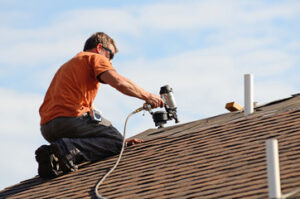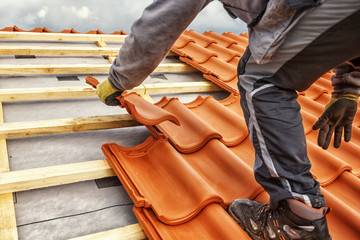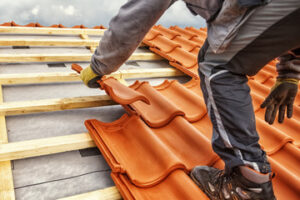Roofing is the top covering of a building and consists of materials and constructions that are used to protect a building from the elements. Roofing materials are used in a variety of constructions and are available in a wide range of prices and styles. It is the most important part of a building’s envelope, protecting it from weather and wind.
Roofing materials are composed of two basic types: rolled and flat. Rolled roofing materials are made from asphalt or bitumen and are relatively cheap and easy to install. They provide a thin, light cover for the roof. Roll materials are often used for low-sloped roofs. They can be easily installed with torch-down methods or by using roofing nails. However, rolled roofing has its downsides. Here are some of the common types of roofing materials.
Depending on the location, different types of roofing materials offer varying degrees of weatherproofing. Many roofs are designed to offer more than one specialized function. While determining which type of roofing material is right for you, the climate of your region will be the determining factor. In some climates, dense materials are not recommended. For this reason, there are several different types of shingles. One type is called thermoplastic, which is great for areas where extreme temperatures are common.
Another type of roofing material is rubber. It is a durable material made of recycled tires. The lifespan of rubber shingles is approximately 50 years. A different type of metal roof is made of copper system shingles. The lifespan of the slate is 80-400 years, depending on the type of slate. Famous slate quarries are located in another country. Traditionally, tile roofing is made from local materials. Today, concrete is often used. A few types of metal roofing are available on the market.
Techniques
Using interlocking roofing techniques dates back to at least 10,000 B.C. in another country. They helped improve roofing technology and materials. In other places, the Romans favored red-tiled roofs, which were both beautiful and durable. Some red-tiled roofs can still be found today. Ceramic roofs are now common in many parts of the world. This solid material is extremely durable and weather-resistant.
There are many different types of roofing, each with its unique benefits and drawbacks. For the most part, however, simple roofs with moderate pitches are easily installable by the do-it-yourselfer with the right tools and knowledge. However, the technique to install different types of roofs will differ. In this article, we’ll explore some of the most common techniques for roofing. And while these are not a must-have for novices, they do require some preparation and knowledge.
The first thing to know when laying shingles is how to measure them properly. Roofing materials come in different sizes and shapes, and they must be matched to the roof’s structure. Be sure to take the time to measure and mark the shingles with a utility knife, or else you may end up with a roof that doesn’t fit right. And make sure to be aware of power lines and other underground utilities. A roof’s structural integrity can be compromised if the material isn’t installed properly.
Cost
Roofing contractors vary widely in terms of price. Overhead expenses, such as advertising, office expenses, equipment and fuel, and Workers’ Compensation insurance are common overhead expenses. These costs can range from 25% to 40% of payroll, depending on the state and past incidents. The type of roofing material that you choose will also affect your cost. In this article, we’ll discuss some of the factors that influence your costs and determine which roofing material is best for your home.
The quality of roofing materials is also an important factor. For instance, an architectural shingle will cost fifty percent more than a standard 3-tab shingle. Likewise, inexpensive materials may save you money, but they will not hold up to harsh weather. If you choose to install a cheap roof, you may end up paying for a new one in the future. Choosing the wrong material can cost you a lot of money, and it could even damage your roof.
Another factor that can affect your cost is your location. Whether you live in the country’s most expensive city or a small town, the climate will have a profound effect on the cost of a roofing project. Local legislation and permit fees also impact the cost of roofing materials. Lastly, you should consider your local economic conditions and competition when choosing a roofing contractor. If the market in your area is unstable, the cost of roofing materials can skyrocket.
Durability
Roofing materials vary in terms of their durability. Their expected useful life may be only 10 years or the entire life of a building. Durability not only affects the cost of construction for the owner but also has wider social and environmental implications. Approximately nine to ten million tons of asphalt roofing is disposed of annually in landfills. Longer-lasting roofing systems can reduce waste sent to landfills and improve the use of embodied energy.
The durability of roofing materials plays a crucial role in the flexibility and longevity of a roofing system. A two-layered membrane can help increase the longevity of a flat roof. But the material must be of the correct thickness and installed correctly to maximize its durability. In addition, the thickness isn’t always a direct correlation between durability and thickness. In some cases, less is more. Choosing the best material for your roofing system will determine its longevity and energy efficiency.
Roofing materials vary considerably in cost, durability, and aesthetics. Asphalt or cedar shingles typically last about fifteen to twenty years, while slate or metal roofing may last for fifty years or more. The cost of each material will vary depending on the location, but there are some exceptions. Also, remember that if your roof leaks, it may not require a total replacement. A simple fix to the leak might be to repair a faulty flashing.
Stone-Coated Steel
A stone-coated steel roof is a unique alternative to traditional asphalt or metal roofs. Stone-coated roofing uses metal or steel as the base material and attaches stone chips to the steel with an acrylic film. The purpose of stone-coated steel roofing is to create a more durable roof while still providing the aesthetic benefits of traditional roofing. To get started with stone-coated steel roofing, follow these steps.
The fire resistance of stone-coated steel roofing is the highest among roofing materials. It outperforms many natural materials when exposed to hot temperatures. This is because steel does not expand and contract as a result of extreme weather conditions. Stone-coated steel is noncombustible and carries a Class A fire rating. It also provides optimized protection from hail. The fire resistance of stone-coated steel panels can withstand hailstones up to two inches in diameter.
Stone-coated steel roofing is an excellent choice for those with extremely high winds and high wind risk. The interlocking panels prevent warping, curling, or splitting, and they won’t absorb water. And because they’re made of steel, stone-coated steel roofing is recyclable. The panels are 100% recyclable. They’re a fantastic choice for homes located in earthquake zones. And best of all, stone-coated steel roofing can also withstand harsh climates.
Wood
Among the different types of roofing materials, wood is used extensively in construction. It has historically been used in residential buildings. While it may be the most economical choice in the past, the process of installing wood roofs is now highly technical, requiring extensive technical training and experience. Nevertheless, wood roofing provides a unique and elegant design structure for a building, lasting for many years. Here are some tips for choosing the right wood for roofing.
First of all, it is important to determine the area to be covered by a wooden roof. Generally, the area of the roof can be estimated by dividing the total area of the wooden tiles by their length. The inclination of the roof should be less than 14o or higher than 18o, as the slope increases with the amount of wood used. Secondly, roofers consider the amount of slope between 18 and 90 degrees. This inclination can greatly impact the lifespan of the roofing material, so a margin of ten to fifteen percent is necessary.
Cedar is the most common type of wood used in roofing systems. With proper care, cedar wood shingles can last up to 40 years. Additionally, many manufacturers treat wooden roofs with fire-resistant chemicals to protect against fire. If you are looking for a natural wood roofing material, cedar is an excellent choice. However, you should make sure to research each type before deciding on a particular wood for your roofing project. There are a lot of different kinds of wood available, and each one has its unique qualities and benefits.



 The roof is one of the most important parts of your home or building. It protects the residents and their belongings from the elements, including wind, rain, snow and extreme temperatures. An updated, sturdy roof makes a home more attractive to potential buyers and can increase its value. It can also help save on energy costs. In addition, a new roof can come with a manufacturer warranty lasting two to 25 years.
The roof is one of the most important parts of your home or building. It protects the residents and their belongings from the elements, including wind, rain, snow and extreme temperatures. An updated, sturdy roof makes a home more attractive to potential buyers and can increase its value. It can also help save on energy costs. In addition, a new roof can come with a manufacturer warranty lasting two to 25 years.